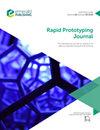通过熔融长丝制造 3D打印技术制造热塑性模具,用于聚氨酯泡沫塑料成型产品的快速原型制作
IF 3.6
4区 工程技术
Q1 ENGINEERING, MECHANICAL
引用次数: 0
摘要
目的 聚氨酯(PUR)泡沫塑料部件传统上使用金属模具制造,这种方法不适合原型设计目的。因此,建议使用聚乳酸(PLA)和乙二醇改性聚对苯二甲酸乙二酯(PETG)熔融长丝制造(FFF)快速制造一次性模具,与传统的金属模具或使用其他难以打印的热塑性塑料进行三维(3D)打印相比,这是一种经济、简单、快速的解决方案、这些热塑性塑料容易收缩和分层(丙烯腈-丁二烯-苯乙烯、聚丙烯-聚苯乙烯),或因材料和打印设备费用而成本高昂(PEEK、聚酰胺或聚碳酸酯-PC)。本研究的目的是评估聚氨酯泡沫与脱模剂结合后在这些材料上的脱模难易程度,以促进混料/脱模过程。 通过三个连续的成型/脱模循环,对 PETG、聚乳酸和可硬化聚乳酸(聚乳酸 3D870)作为模具材料与水基和溶剂型脱模剂的组合进行了全面的实验设计评估。 结果表明,聚乳酸 3D870 的脱模性最好。已打印出专门用于制造泡沫垫的模具,并成功实现了原型制作。使用溶剂型脱模剂更容易脱模,而使用水基脱模剂则质量更好。 独创性/价值 聚乳酸 3D870 和 FFF 与无溶剂水基脱模剂的结合,为传统金属模具和其他 3D 打印热塑性塑料提供了一种令人信服的低成本、环保型替代方案。这种创新方法是 PUR 泡沫成型中快速模具的可行选择。本文章由计算机程序翻译,如有差异,请以英文原文为准。
Manufacture of thermoplastic molds by fused filament fabrication 3D printing for rapid prototyping of polyurethane foam molded products
Purpose Polyurethane (PUR) foam parts are traditionally manufactured using metallic molds, an unsuitable approach for prototyping purposes. Thus, rapid tooling of disposable molds using fused filament fabrication (FFF) with polylactic acid (PLA) and glycol-modified polyethylene terephthalate (PETG) is proposed as an economical, simpler and faster solution compared to traditional metallic molds or three-dimensional (3D) printing with other difficult-to-print thermoplastics, which are prone to shrinkage and delamination (acrylonitrile butadiene styrene, polypropilene-PP) or high-cost due to both material and printing equipment expenses (PEEK, polyamides or polycarbonate-PC). The purpose of this study has been to evaluate the ease of release of PUR foam on these materials in combination with release agents to facilitate the mulding/demoulding process. Design/methodology/approach PETG, PLA and hardenable polylactic acid (PLA 3D870) have been evaluated as mold materials in combination with aqueous and solvent-based release agents within a full design of experiments by three consecutive molding/demolding cycles. Findings PLA 3D870 has shown the best demoldability. A mold expressly designed to manufacture a foam cushion has been printed and the prototyping has been successfully achieved. The demolding of the part has been easier using a solvent-based release agent, meanwhile the quality has been better when using a water-based one. Originality/value The combination of PLA 3D870 and FFF, along with solvent-free water-based release agents, presents a compelling low-cost and eco-friendly alternative to traditional metallic molds and other 3D printing thermoplastics. This innovative approach serves as a viable option for rapid tooling in PUR foam molding.
求助全文
通过发布文献求助,成功后即可免费获取论文全文。
去求助
来源期刊

Rapid Prototyping Journal
工程技术-材料科学:综合
CiteScore
8.30
自引率
10.30%
发文量
137
审稿时长
4.6 months
期刊介绍:
Rapid Prototyping Journal concentrates on development in a manufacturing environment but covers applications in other areas, such as medicine and construction. All papers published in this field are scattered over a wide range of international publications, none of which actually specializes in this particular discipline, this journal is a vital resource for anyone involved in additive manufacturing. It draws together important refereed papers on all aspects of AM from distinguished sources all over the world, to give a truly international perspective on this dynamic and exciting area.
-Benchmarking – certification and qualification in AM-
Mass customisation in AM-
Design for AM-
Materials aspects-
Reviews of processes/applications-
CAD and other software aspects-
Enhancement of existing processes-
Integration with design process-
Management implications-
New AM processes-
Novel applications of AM parts-
AM for tooling-
Medical applications-
Reverse engineering in relation to AM-
Additive & Subtractive hybrid manufacturing-
Industrialisation
 求助内容:
求助内容: 应助结果提醒方式:
应助结果提醒方式:


